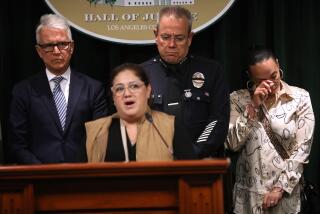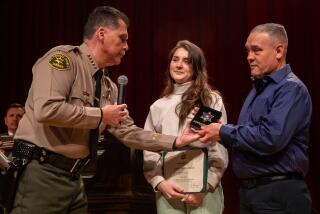‘Health’s Angel’ Pushes Motorcycle Safety : Highways: Federal regulator joins motorcycle riders to stress need for training courses. As an ER doctor, he also strongly supports helmet use.
- Share via
WASHINGTON — Just call him Easy Regulator.
The National Highway Traffic Safety Administration’s Ricardo Martinez is now a graduate of a two-day motorcycle training course, taken with eight other NHTSA officials who are involved in motorcycle regulation and who often differ with bikers on one very sensitive subject: helmets.
Administrator Martinez and his Honda 250, “Bubba,” are fresh from the course sponsored by the state of Maryland and coordinated by two motorcycle groups. Martinez said the experience brought back memories of college days at Louisiana State University, when he took to flat roads on a bike he acquired in a trade for stereo speakers.
“Going up in the levees was just a joy,” he said.
The love affair lasted 18 months, until he got a call from his father, who didn’t want him to become a statistic in an emergency room. The bike got traded again.
The idea of Martinez, now an emergency-room physician, climbing on a bike and getting close to the asphalt with seasoned motorcyclists was intended to give him a bikers’ view of safety. It also was designed to show bikers that NHTSA cares as much about rider education as it does about helmet laws.
“The agency has a strong interest in motorcycling,” Martinez said, especially since the sport’s demographics are changing. There are more women and professionals on motorcycles; riders are older, and their incomes are increasing. There are 6.6 million motorcycles in use, up from 5.1 million in 1990, reports the Motorcycle Safety Foundation in Irvine, Calif.
Helmet laws are a state issue. NHTSA has long played an advocacy role for helmet laws, much as it promotes the use of seat belts and child car seats.
Washington, D.C., and 22 states require helmets for all riders. Other states require helmets for certain riders, usually those under 18. Colorado, Illinois and Iowa have no helmet laws.
The agency and some biking groups have sparred over NHTSA’s role for some time. Their differences culminated last year when bikers got language inserted into federal highway legislation barring NHTSA from favoring or opposing any specific state legislative proposal.
“It’s inappropriate use of tax dollars that a federal agency lobbies at the state level,” said Steve Zimmer, vice president of government relations for the Motorcycle Riders Foundation. Some bikers were further incensed by a recent NHTSA video called “Without Motorcycle Helmets We All Pay the Price,” suggesting injured bikers are a burden on society.
Many bikers oppose any helmet laws, insisting they are as well insured as other motorists. But Zimmer said most motorcyclists are not against helmets, and usage runs from 60% to 80% even in states without helmet laws.
Ed Moreland, Washington representative for the American Motorcyclist Assn., which represents 235,000 bikers, said helmets are an important element in biker safety but maybe not the most important one.
“It’s only one element in a comprehensive approach. A properly trained rider is more likely not to be in the wrong place at the wrong time,” said Moreland. “Training is more likely to save lives than putting a helmet on them and sending them on their way.”
The Maryland course, for example, included instruction on risk awareness, street strategies, and turning and braking.
But Martinez likely won’t change his mind about helmets, especially after his emergency-room exposure to biker head injuries.
Cyclists are like “the egg outside the carton,” he said. They’re 15 times more likely than car occupants to die in a crash--and many of the deaths are from head injuries. Most biker accidents are caused by car drivers not seeing the cyclist or turning in front of him.
Still, Martinez said he’s ready to get a motorcycle license now that he’s trained. He’s pushing the National Agenda for Motorcycle Safety, a blueprint developed by bikers and the agency to promote safety at the local level.
He cut a decidedly nonregulatory figure in blue chambray shirt, jeans, boots, bandanna and multicolored helmet. Colleagues and instructors said he was an “exceptional” student, in the classroom and on “Bubba,” though he never left the parking lot.
“He kept looking off into the distance,” said one attendee, suggesting Martinez may have been longing for the open road.
More to Read
Sign up for Essential California
The most important California stories and recommendations in your inbox every morning.
You may occasionally receive promotional content from the Los Angeles Times.










